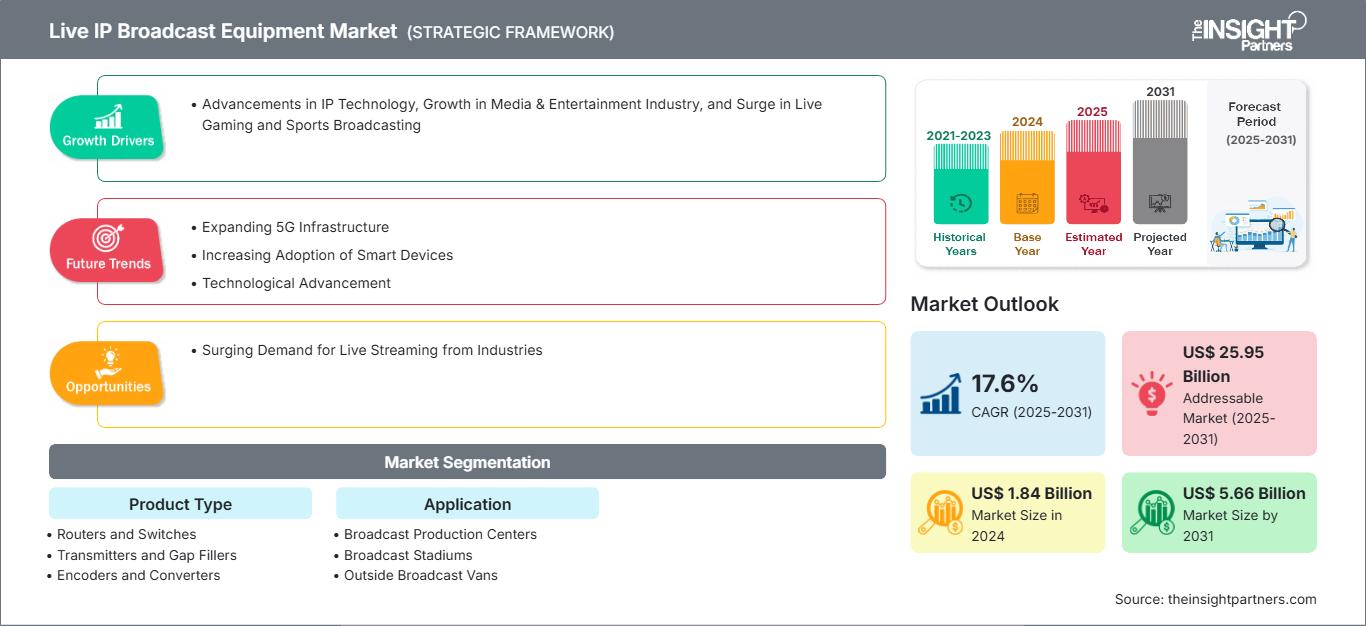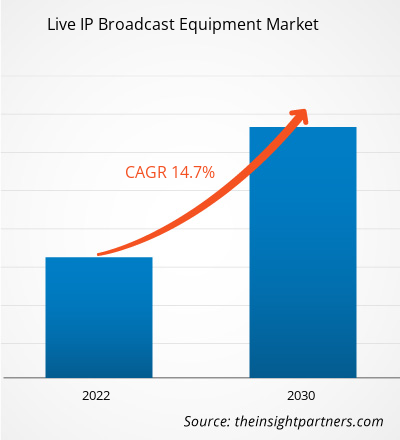Der Markt für Live-IP-Übertragungsgeräte hatte im Jahr 2024 einen Wert von 1,84 Milliarden US-Dollar und soll bis 2031 5,66 Milliarden US-Dollar erreichen; für den Zeitraum 2025–2031 wird eine durchschnittliche jährliche Wachstumsrate (CAGR) von 17,6 % erwartet. Die steigende Nachfrage der Industrie nach Live-Streaming dürfte zukünftige Markttrends mit sich bringen.
Marktanalyse für Live-IP-Übertragungsgeräte
Inhalte, die in 4K- und Ultra-High-Definition-Formaten (UHD) produziert werden, müssen für eine verbesserte Wiedergabequalität in einem ähnlichen Format übertragen werden, was eine effektive IP-Live-Produktionstechnologie erfordert. Die Medien- und Unterhaltungsindustrie wächst rasant und trägt zum Wachstum des Marktes für Live-IP-Übertragungsgeräte bei. Die Integration innovativer Technologien in die digitale Medienbranche ist ein Trend in Live-Streaming-Medienunternehmen. Unternehmen konzentrieren sich auf digitale Technologien, um eine Marke aufzubauen und neue Produkte für die Herstellung kostengünstiger Hardware für Rundfunkanstalten zu präsentieren, wobei Live-Streaming im Vordergrund steht.
Marktübersicht für Live-IP-Broadcast-Geräte
Live-IP-Broadcast-Geräte erfassen, verarbeiten und übertragen Live-Audio- und Videoinhalte über internetbasierte Netzwerke statt über traditionelle Rundfunkinfrastrukturen wie Satelliten- oder Koaxialsysteme. Die Umstellung auf IP (Internet Protocol) ermöglicht Rundfunkanstalten und Inhaltserstellern die Produktion und Verbreitung von Live-Videos flexibler, skalierbarer und oft kostengünstiger. Die steigende Nachfrage nach Direct-to-Consumer-Produkten (D2C) über OTT-Dienste und Mehrkanalnetzwerke, die Digitalisierung, laufende Investitionen in Forschung und Entwicklung zur Entwicklung neuer Fertigungssysteme sowie steigende IT-Ausgaben treiben die Nachfrage weiter an. Das Marktwachstum wird durch Fortschritte in der IP-Technologie, die Verbreitung der Medien- und Unterhaltungsbranche und einen Anstieg der Live-Übertragung von Spielen und Sportveranstaltungen vorangetrieben. Technologische Fortschritte und die Modernisierung der Ausrüstung, der Ausbau der 5G-Infrastruktur, die zunehmende Verbreitung intelligenter Geräte und die steigende Nachfrage nach Live-Streaming-Kanälen werden den Unternehmen, die auf dem Markt für Live-IP-Übertragungsgeräte tätig sind, in Zukunft voraussichtlich zugutekommen.
Passen Sie diesen Bericht Ihren Anforderungen an
Sie erhalten kostenlos Anpassungen an jedem Bericht, einschließlich Teilen dieses Berichts oder einer Analyse auf Länderebene, eines Excel-Datenpakets sowie tolle Angebote und Rabatte für Start-ups und Universitäten.
Markt für Live-IP-Broadcast-Geräte: Strategische Einblicke

-
Holen Sie sich die wichtigsten Markttrends aus diesem Bericht.Dieses KOSTENLOSE Beispiel umfasst Datenanalysen, die von Markttrends bis hin zu Schätzungen und Prognosen reichen.
Markttreiber und Chancen für Live-IP-Broadcast-Equipment
Wachstum in der Medien- und Unterhaltungsbranche
Laut einem Bericht von CII GT wird Indiens Animations- und VFX-Branche voraussichtlich von 1,3 Milliarden US-Dollar im Jahr 2023 auf 2,2 Milliarden US-Dollar im Jahr 2026 wachsen, was einer Steigerung ihres Beitrags zum Medien- und Unterhaltungssektor (M&E) von 5 % auf 6 % entspricht. Laut der International Trade Administration (ITA) hatte die US-amerikanische M&E-Branche im Jahr 2024 einen Wert von 649 Milliarden US-Dollar (des weltweiten Marktes von 2,8 Billionen US-Dollar). Im Jahr 2023 beliefen sich die ausländischen Direktinvestitionen in der Film- und Tonaufnahmebranche auf 35,2 Milliarden US-Dollar und in der Rundfunk- und Kabelrundfunkbranche auf 8,9 Milliarden US-Dollar. Laut einem Bericht von CII GT wird Indiens Animations- und VFX-Sektor voraussichtlich von 1,3 Milliarden US-Dollar im Jahr 2023 auf 2,2 Milliarden US-Dollar im Jahr 2026 wachsen und seinen Beitrag zur M&E-Branche von 5 % auf 6 % erhöhen. Daten von YouTube zeigen, dass die Wiedergabedauer von Live-Streams um 250 % gestiegen ist. Laut dem „Live Streaming Trends Report 2024“ von Stream Hatchet verzeichnete Live-Streaming einen Anstieg der Wiedergabedauer im Vergleich zum Vorjahr um 12 % auf insgesamt 32,5 Milliarden Stunden.
Die Nachfrage nach erschwinglichen und flexiblen Lösungen für Remote-Beiträge, Live-Streaming, IP-basierte Produktion und AV-over-IP steigt. Die steigende Nachfrage nach Ultra-High-Definition-Inhalten (UHD), der Übergang zu Cloud-basierten Produkten, Lösungen, Apps und offener Architektur, Investitionen in Hochgeschwindigkeits-Breitbandinfrastruktur, die Nachfrage nach Videokonsum auf mehreren Bildschirmen und die Entwicklung von Over-the-Top-Diensten (OTT) treiben das Marktwachstum an. Im Mai 2022 gab Sony Sports Network in Indien bekannt, dass Roland-Garros 2022, das zweite Grand-Slam-Event, live in vier Regionalsprachen übertragen wird. Das Turnier wurde auf Sony Sports Networks On-Demand-OTT-Plattform SonyLIV gestreamt. Mitte März 2020 meldete Google einen Anstieg der Suchanfragen nach Live-Streaming-Plattformen um 300–500 %.
Technologische Fortschritte und steigende Nachfrage nach Live-Streaming-Kanälen
Es besteht ein wachsender Bedarf, die Netzwerkbandbreite zu optimieren und die Verbraucherbasis für Live-Streaming-Inhalte zu erweitern. Im April 2023 kündigte Google an, über 800 Live-Streaming-Kanäle, darunter NBC, CBS, ABC und Fox, in einem neuen Leitfaden in der Google TV-Oberfläche zusammenzuführen. Unternehmen konzentrieren sich auf digitale Technologien, um eine Marke aufzubauen und neue Produkte für die Herstellung kostengünstiger Hardware für Sender vorzustellen, wobei Live-Streaming im Vordergrund steht. Im Jahr 2021 ging Innovative Systems, Inc. (USA) eine Partnerschaft mit Midwest Video Solutions (USA) ein, um einen vollständig gehosteten End-to-End-Streaming-Videodienst bereitzustellen. Im Jahr 2021 schloss FilmMyMatch (USA) eine Vereinbarung mit JOYMO (Norwegen), um Kunden in ganz Großbritannien Live-Streaming, Videoverwaltung und Produktionsdienste anzubieten. Laut Vedico bevorzugen über 70 % der Verbraucher der Generation Z Live-Inhalte eindeutig gegenüber traditionellem Fernsehen, getrieben von ihrem Wunsch nach authentischen Erlebnissen und Echtzeit-Engagement. Im Januar 2025 führte Comcast Sports & ein News TV, ein neues Videoangebot für Xfinity-Internetabonnenten, das Live-Nachrichten, Top-Sportereignisse der NFL, NBA, NHL, MLB und NCAA sowie beliebte Filme, Fernsehsendungen und Primetime-Programme in einem einzigen, umfassenden Paket vereint. Daher wird erwartet, dass der laufende technologische Fortschritt und die steigende Nachfrage nach Live-Streaming-Kanälen dem Markt für Live-IP-Übertragungsgeräte künftige Wachstumschancen bieten.
Segmentierungsanalyse des Marktberichts für Live-IP-Übertragungsgeräte
Wichtige Segmente, die zur Ableitung der Marktanalyse für Live-IP-Übertragungsgeräte beigetragen haben, sind Produkttyp und Anwendung.
- Basierend auf dem Produkttyp ist der Markt für Live-IP-Übertragungsgeräte in Sender und Lückenfüller, Encoder und Konverter, Verstärker, Antennen, Modulatoren und Repeater, Router und Switches, Videoserver, IP-Synchronisierungsgeräte, PTP-Server und andere segmentiert. Das Segment Router und Switches dominierte den Markt im Jahr 2024.
- Basierend auf der Anwendung ist der Markt für Live-IP-Übertragungsgeräte in Übertragungsstadien, Übertragungswagen im Freien und Übertragungsproduktionszentren unterteilt. Das Segment Übertragungsproduktionszentren dominierte den Markt im Jahr 2024.
Marktanteilsanalyse für Live-IP-Übertragungsgeräte nach Geografie
- Der Markt für Live-IP-Übertragungsgeräte ist in fünf Hauptregionen unterteilt: Nordamerika, Europa, Asien-Pazifik (APAC), Naher Osten und Afrika (MEA) sowie Süd- und Mittelamerika. Der Asien-Pazifik-Raum dominierte den Markt für Live-IP-Übertragungsgeräte im Jahr 2024. Nordamerika leistet den zweitgrößten Beitrag zum globalen Markt für Live-IP-Übertragungsgeräte, gefolgt von Europa.
- Der Markt für Live-IP-Übertragungsgeräte in Nordamerika ist in die USA, Kanada und Mexiko unterteilt. Diese Länder gelten weltweit als Vorreiter bei der Einführung digitaler Technologien. In der Region bieten Netflix, Amazon Prime Video, Disney+ und Paramount+ ein vielfältiges Portfolio an Inhaltsangeboten, darunter Live-Sport, Spielfilme, Fernsehserien und exklusive Originalproduktionen. Nachrichtensender weiten ihre Präsenz auf OTT-Plattformen aus und ermöglichen ihrem Publikum einen flexibleren Zugriff auf Live-Übertragungen und On-Demand-Nachrichteninhalte. Das globale Medien- und Unterhaltungsteam (M&E) des ITA verfügt über Exportbüros in über 100 US-Städten und bei 80 Botschaften und unterstützt die M&E-Branche und ihre Kunden mit Lizenzierungs- und Handelsdienstleistungen bei der Expansion auf den internationalen Märkten. Das Team hilft Unternehmen dieser Branche beim Ausbau ihrer digitalen Medien, M&E-Produktion, Live-Videospiele und E-Sport, Streaming, Fernsehen oder Rundfunksegmente. Eine robuste M&E-Branche in den USA unterstützt das Wachstum dieser Branche in Kanada und Mexiko mit Hilfe des Handelsabkommens zwischen den USA, Kanada und Mexiko. Laut ITA wird die US-Medien- und Unterhaltungsbranche (M&E) im Jahr 2024 einen Wert von 649 Milliarden US-Dollar erreichen (des weltweiten Marktes von 2,8 Billionen US-Dollar).
Markt für Live-IP-Broadcast-Ausrüstung
Die Analysten von The Insight Partners haben die regionalen Trends und Faktoren, die den Markt für Live-IP-Broadcast-Equipment im Prognosezeitraum beeinflussen, ausführlich erläutert. In diesem Abschnitt werden auch die Marktsegmente und die geografische Lage in Nordamerika, Europa, dem asiatisch-pazifischen Raum, dem Nahen Osten und Afrika sowie Süd- und Mittelamerika erörtert.Umfang des Marktberichts über Live-IP-Broadcast-Geräte
| Berichtsattribut | Einzelheiten |
|---|---|
| Marktgröße in 2024 | US$ 1.84 Billion |
| Marktgröße nach 2031 | US$ 5.66 Billion |
| Globale CAGR (2025 - 2031) | 17.6% |
| Historische Daten | 2021-2023 |
| Prognosezeitraum | 2025-2031 |
| Abgedeckte Segmente |
By Produkttyp
|
| Abgedeckte Regionen und Länder |
Nordamerika
|
| Marktführer und wichtige Unternehmensprofile |
|
Dichte der Marktteilnehmer für Live-IP-Broadcast-Geräte: Auswirkungen auf die Geschäftsdynamik verstehen
Der Markt für Live-IP-Broadcast-Equipment wächst rasant. Dies wird durch die steigende Endverbrauchernachfrage aufgrund veränderter Verbraucherpräferenzen, technologischer Fortschritte und eines stärkeren Bewusstseins für die Produktvorteile vorangetrieben. Mit der steigenden Nachfrage erweitern Unternehmen ihr Angebot, entwickeln Innovationen, um den Bedürfnissen der Verbraucher gerecht zu werden, und nutzen neue Trends, was das Marktwachstum weiter ankurbelt.

- Holen Sie sich die Markt für Live-IP-Broadcast-Geräte Übersicht der wichtigsten Akteure
Neuigkeiten und aktuelle Entwicklungen zum Markt für Live-IP-Broadcast-Geräte
Der Markt für Live-IP-Broadcast-Geräte wird durch die Erhebung qualitativer und quantitativer Daten nach Primär- und Sekundärforschung bewertet, die wichtige Unternehmensveröffentlichungen, Verbandsdaten und Datenbanken umfasst. Die wichtigsten Entwicklungen auf dem Markt für Live-IP-Broadcast-Geräte sind unten aufgeführt:
- Belden hat Voleatech für 5,0 Millionen Euro (5,6 Millionen US-Dollar) abzüglich der erworbenen Barmittel übernommen. Die Übernahme beinhaltet einen potenziellen Earn-out von bis zu 3,0 Millionen Euro, der auf bestimmten Zielen über drei Jahre basiert und als Vergütungsaufwand verbucht wird. Voleatech mit Sitz in Deutschland ist für seine VT AIR Next Gen Firewall bekannt und erweitert Beldens Firewall-Produktportfolio und die allgemeine Sicherheitsplanung in OT-Netzwerken. Voleatech wird im Segment Automatisierungslösungen ausgewiesen.
(Quelle: Belden, Pressemitteilung, September 2024)
- Grass Valley, ein Anbieter von Live-Produktionslösungen, gab bekannt, dass das skandinavische Unternehmen für Remote-Videoproduktion DMC Production (DMC) seine Live-Berichterstattung von der RallyX 2024 revolutioniert hat. Dabei nutzt das Unternehmen Grass Valley AMPP, um die spannenden Motorsportrennen und die Meisterschaft in außergewöhnlicher Qualität live über YouTube zu streamen.
(Quelle: Grass Valley, Pressemitteilung, Juni 2024)
Marktbericht zu Live-IP-Broadcast-Equipment: Abdeckung und Ergebnisse
Der Bericht „Marktgröße und Prognose für Live-IP-Broadcast-Equipment (2021–2031)“ bietet eine detaillierte Analyse des Marktes und deckt die unten genannten Bereiche ab:
- Marktgröße und Prognose für Live-IP-Broadcast-Equipment auf globaler, regionaler und Länderebene für alle abgedeckten wichtigen Marktsegmente
- Live-IP-Broadcast-Equipment Markttrends sowie Marktdynamiken wie Treiber, Einschränkungen und wichtige Chancen
- Detaillierte PEST- und SWOT-Analyse
- Marktanalyse für Live-IP-Broadcast-Geräte, die wichtige Markttrends, globale und regionale Rahmenbedingungen, wichtige Akteure, Vorschriften und aktuelle Marktentwicklungen abdeckt
- Branchenlandschafts- und Wettbewerbsanalyse, die Marktkonzentration, Heatmap-Analyse, prominente Akteure und aktuelle Entwicklungen für den Markt für Live-IP-Broadcast-Geräte abdeckt
- Detaillierte Unternehmensprofile
- Historische Analyse (2 Jahre), Basisjahr, Prognose (7 Jahre) mit CAGR
- PEST- und SWOT-Analyse
- Marktgröße Wert/Volumen – Global, Regional, Land
- Branchen- und Wettbewerbslandschaft
- Excel-Datensatz
Aktuelle Berichte
Verwandte Berichte
Erfahrungsberichte
Grund zum Kauf
- Fundierte Entscheidungsfindung
- Marktdynamik verstehen
- Wettbewerbsanalyse
- Kundeneinblicke
- Marktprognosen
- Risikominimierung
- Strategische Planung
- Investitionsbegründung
- Identifizierung neuer Märkte
- Verbesserung von Marketingstrategien
- Steigerung der Betriebseffizienz
- Anpassung an regulatorische Trends






















 Kostenlose Probe anfordern für - Markt für Live-IP-Broadcast-Geräte
Kostenlose Probe anfordern für - Markt für Live-IP-Broadcast-Geräte